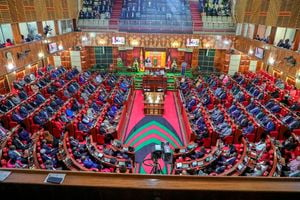40 Nairobi posho mills to process cheap unga

Kenya's Agriculture Cabinet Secretary Willy Bett (right) and his Zambia counterpart Dora Siliya during a press conference at Kilimo House in Nairobi on July 4, 2017. PHOTO | SALATON NJAU | NATION MEDIA GROUP
What you need to know:
- Since the importation of maize started, the commodity has been distributed to large millers for processing.
- The Zambian government has given Kenya direct access to agricultural products such as maize and sugar.
The government has identified 40 posho mills in Nairobi County to be allocated imported maize for processing.
Agriculture Cabinet Secretary Willy Bett said additional millers have been identified in Samburu and Turkana counties, among the places packaged subsidised unga has not reached.
He said the move is aimed at ensuring that subsidised maize flour is easily accessible in all parts of the country.
He said they have identified the millers in informal settlements, where locals can buy the cheap unga.
DEFICIT
“Because of the availability of maize, we are able to extend the distribution to the posho mills,” Mr Bett said during a briefing at his office on Tuesday.
Last month, the Agriculture Ministry launched a subsidy programme on the flour, Kenya’s staple food, meant to reduce the price of a two-kilogramme packet from Sh160 to Sh90.
Since imports of maize started, the commodity has been distributed to large millers for milling.
Meanwhile, the Zambian government has given Kenya direct access to agricultural products such as maize and sugar.
This means Kenya can now import maize from Zambia to bridge the deficit following a poor harvest last year.
SPECIAL LANE
Mr Bett and Zambian agriculture minister Dora Siliya on Tuesday signed bilateral trade agreements to effect the easy movement of agricultural commodities between the two states.
Ms Siliya said her government has committed to dedicate a special lane on its roads to facilitate express clearance for maize and sugar exports to Kenya.
This follows Tanzania's decision to restrict movement of grains by closing its borders to protect its limited stocks.
She also confirmed the elimination of a maize export ban imposed last year and the removal of a 10 per cent surtax on maize exports.
The Zambian government has also shortened the processing of permits for imports from seven days to a day.
INSPECTION
For its part, the Kenyan government, through the Kenya Bureau of Standards, will carry out destination inspection on imported maize from the southern African country on condition that the exporters adhere to the required moisture content and aflatoxin levels.
It has also waived duty on imported maize, sugar and milk until the situation normalises.
“The removal of these bottlenecks will increase more agricultural trade between the two countries,” Mr Bett said.
The minister said the government wants to import about 100,000 tonnes of maize from Zambia.
The Zambian minister said her country has a surplus of 1.4 million tonnes of maize and 40,000 metric tonnes of sugar that is available for export.





